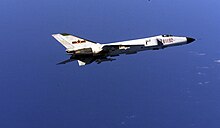PL-8
The PL-8 is a Chinese short-range air-to-air missile .
development
The PL-8 is a licensed copy of the Israeli Python-3 rocket. The reconstruction of this missile began in 1983 after the Air Force of the People's Republic of China had fired some Python-3 missiles as a test and were satisfied with their performance. To get production up and running quickly, Israel shipped 1,200 sets of components to China. The rockets produced from it were delivered in 1988. In the further course of the program, the proportion of Israeli components was gradually reduced so that China could manufacture the PL-8 completely independently at the end of the 1990s.
technology
Compared to the previous models ( PL-2 , PL-5 , PL-7 ), the PL-8 offers some significant improvements. It is the first Chinese rocket to have an "all-aspect" infrared seeker head. This makes it possible to attack enemy aircraft from all directions (also from the front). In the past it was necessary to bring one's own machine behind that of the opponent so that the infrared seeker could detect the hot engine outlets of the opponent. However, the sensor of the PL-8 is sensitive enough to be able to target the heated cell itself. The hardware and software have also been significantly improved so that the missile can attack difficult targets and react better to evasive maneuvers. Later versions should also be able to interact with a helmet-based target system. This enables the pilot to capture a target by aligning his gaze on it. The helmet registers the direction in which the pilot is looking and aligns the sensor accordingly.
Platforms
- Chengdu J-7
- Shenyang J-8 Finback
- Chengdu J-10 Vigorous Dragon
Technical specifications
| Parameter | Data |
|---|---|
| length | 2.99 m |
| diameter | 0.16 m |
| span | 0.81 m |
| Takeoff weight | 115 kg |
| speed | Do 2 |
| Maximum range | 15 km |
| Minimal range | 0.5 km |
| steering | "All-Aspect", infrared |
| Warhead | 10 kg HE-Frag (proximity fuse) |
| drive | Solid rocket |
| Load limit | 35 g |
